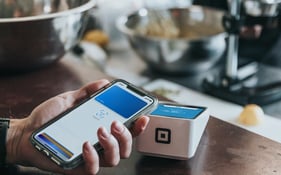The restaurant industry has never seen anything like the coronavirus pandemic. Here's hoping it never will again. But as they say, "hope is not a strategy," and if you’re reading this, we're guessing you're not satisfied with crossing your fingers.
Is there a way to run your restaurant in the post-COVID-19 era while hedging against the debilitating effects of some future catastrophe? We can’t say for sure—no one can. But here are some ideas from smart folks around the industry for how independent operators can “future-proof” their restaurants against whatever comes next.
Learnign from COVID-19
The most resilient restaurants during the pandemic responded in three key ways:
They got more flexible with their operations, and less flexible with their menus.
They diversified their revenue streams to maintain cashflow and meet customer demand.
They embraced on-premise and off-premise technology and leaned heavily on social-media messaging (even moreso than normal.)
Of course, most restaurants that made it through the coronavirus catastrophe were also forced to lay off most of their staff to reduce overhead. To insulate your own business against a similar downturn, you may be forced to do the same—even if you put these steps into practice. Being future-proof doesn’t mean being exempt from tough choices. But it’s better than nothing.
Cash-only cannot stand
It didn’t take a global pandemic to showcase how essential credit cards had become in customers’ lives—we already knew that—but it did reveal the brutal limitations of cash-only businesses. To set your restaurant up to succeed, cashless transactions must be part of your checkout process.
You can (and should!) still accept paper bills for payment, and mobile payment options like Apple Pay and Samsung Pay aren’t essential. But you need to be able to swipe plastic. It’s more hygienic than cash, it incentivizes larger orders, and most importantly, it’s what customers want.
Your restaurant, online
Restaurants are fundamentally IRL businesses. But the pandemic showed us that they can’t afford to be strictly IRL businesses anymore—at least not if they want to be stable in our post-pandemic future. It’s no longer viable to slap together a SquareSpace website with photos and hours, claim your business on Google, and call it a day. Restaurants with a strong online presence have a several-step headstart on the pack when a crisis makes it impossible to drive revenue through dining room sales.
Whether you’re reopening your restaurant, or launching a new concept, now is the time to invest in a robust digital footprint. Don’t wait until the COVID-20 (or a hurricane, or whatever) is upon you.
By robust, we mean:
A website with e-commerce capabilities
An email subscription sign-up
An Instagram for Business account with a complete profile
Claimed pages on Yelp, Google, Facebook, and TripAdvisor
Online ordering (see below)
Get going on to-go
Restaurant operators around the country made quick pivots to delivery/takeout business models to stay afloat as the coronavirus pandemic swept across the country. It was a testament to the flexibility, creativity, and decision-making skills this industry demands of small-business owners every day. But: there’s no reason to wait for the next natural/national disaster to get your to-go game in gear. In fact, please don’t do that.
If you want your restaurant to succeed in uncertain times, build some form of takeout into its business model from the very beginning. Some considerations to take into account:
Menu design: Will your existing menu/cuisine work in to-go containers? What would a pared-down, delivery-only menu look like for your restaurant?
Pre-orders: Can you batch orders in the morning for pick-up in the evening? How will that change your chef’s ordering habits for daily deliveries? Who needs to be BOH for batch prep?
Transactions: Do you want use a 3rd-party delivery service’s platform to facilitate transactions? Are you going to hire someone to develop an in-house option? Phone only?
Staff training: Beyond the basics of order fulfillment, how will your FOH run pick-ups safely and securely? Do you have protocols for contactless pickup?
Delivery: 3rd-party or in-house? All services or just a few? More limited menu than takeout?
Meal kits & markets
Some of the most resilient restaurant operators in the pandemic survived in part by creating impromptu “meal kit” plans or using their brick-’n-mortars as makeshift grocery markets. In future cases when food access is strained and/or would-be customers are staying indoors, these are both good tools to have in your arsenal to create temporary cashflow.
Other benefits include:
Temp jobs for displaced FOH/BOH employees in a crisis
Community-building and neighborhood support during a crisis
Viable secondary revenue streams in non-crises
Training positions for junior staffers in non-crises
Don’t miss out on restaurant merch
Most restaurant operators understand the value of a gift-card program, and online sales of same gave many operators crucial money to get through the pandemic. But for every restaurant that survived, dozens failed. Knowing that might happen, many sympathetic but cash-strapped customers opted to buy merchandise instead. After all, gift-cards become worthless when their issuers go out of business, but a hoodie or baseball hat survives.
If you don’t have merch, you’re missing passive revenue opportunities during non-crises, and putting yourself in the hole for the future. (Getting t-shirts designed, printed, photographed, etc. during a disaster is a tough ask.)
Focus on products that allow you to charge a premium, maximize your margin, and fit into your brand and your customers’ lives:
Softgoods like hoodies and t-shirts
Hats—baseball, trucker, and otherwise
Posters and prints
Glassware
Pro-tip: Check out our guide for getting an online restaurant merch game up to speed.
Incorporate artificial intelligence
Bear with us here. During the coronavirus pandemic, supply chains were disrupted and customer preferences went haywire. Restaurateurs that normally have a laser-focus on how and how much to buy, and what their customers want, had to scramble. In this chaos, some operators found success leaning on artificial intelligence to help them make calls about what to stock, what to offer, and when demand would peak and ebb.
Big groups and franchises have been using A.I. for a while now, but more recently the technology has been packaged for smaller independent operators. It’s not a silver bullet, but if you can get an edge and be confident in your decisions in a crisis, that’s a win.
BONUS: Loyalty is a lifeline
This article focuses on tactical solutions, and that’s probably (rightly) what you’re here to read about. But one quick note before you go. During the coronavirus pandemic, some restaurants saw an outpouring of community support to their crowdfunding efforts and hastily made delivery menus, and others didn’t.
The key differentiator between the restaurants that got love and those that got ignored? How well they had engaged with their existing customer base and their community before the crisis occurred. Having strong brand loyalty in place was vital for restaurateurs during the pandemic, and it’s something your restaurant should be actively cultivating in times of calm. Make personal connections, contribute to local events, drill hospitality practices into your staff no matter what. That way, if/when the next calamity goes down, your loyal customers will be ready to throw you a lifeline.





